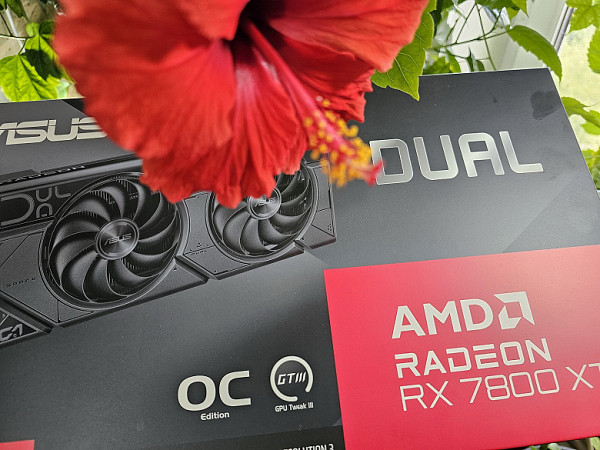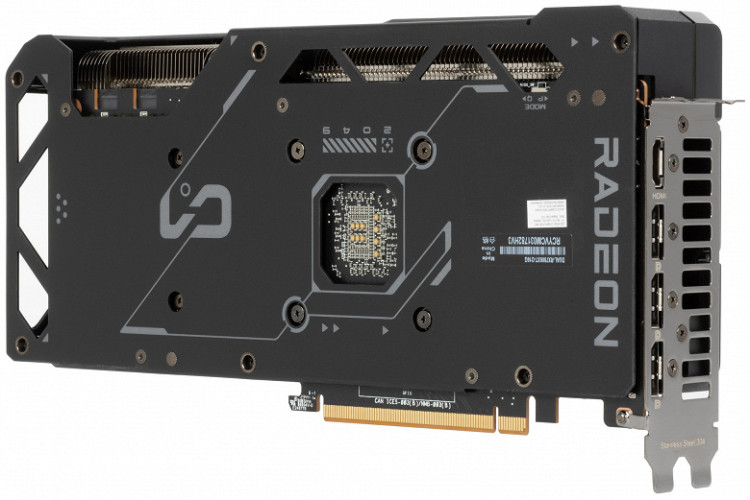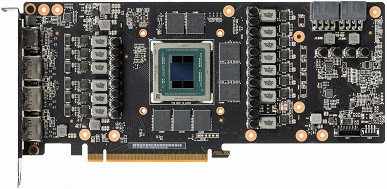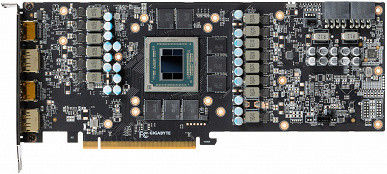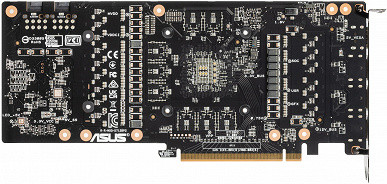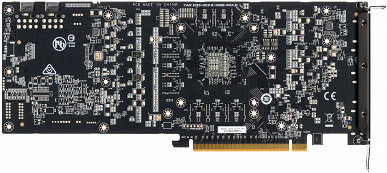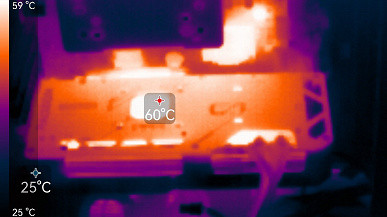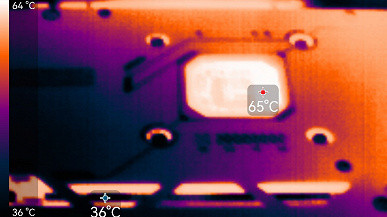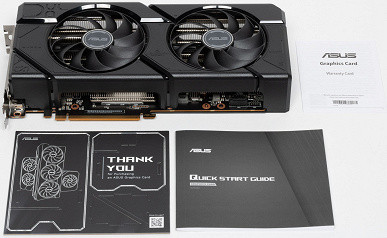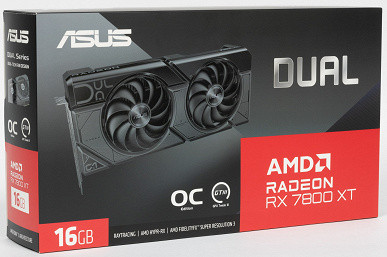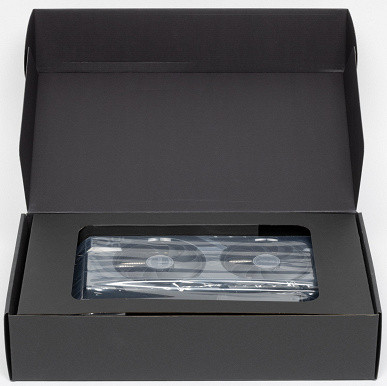Briefly about the main thing
By the beginning of autumn 2024, there is a complete lull in the video card market. There are no new releases in sight, only occasionally there is news like: «Let's replace GDDR6 memory with GDDR6X — maybe no one will notice!» However, this news concerns the GeForce RTX 4070, and today we will pay attention to a video card that does not belong to the Nvidia family.
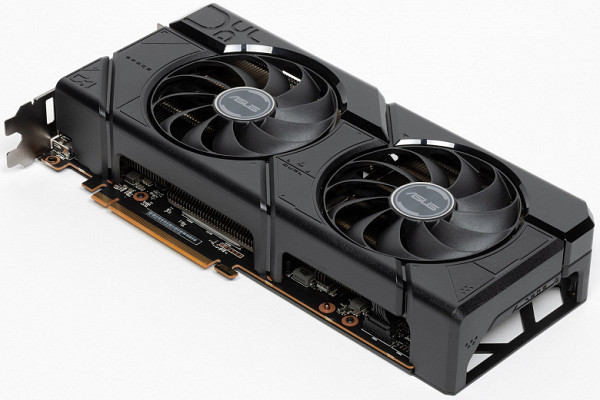
So, we continue to analyze video cards based on the latest GPUs from AMD. In our review, we have the fourth most productive accelerator from this series — Radeon RX 7800 XT from Asus. We are looking at a model from the budget Dual line, which stands out for its minimalist design and lack of backlighting or other frills.
Before moving on to detailed tests, we will provide brief information about the performance of the family to which this accelerator belongs, as well as its competitive models. All this will be assessed subjectively on a seven-point scale.
Games without ray tracing (classic rasterization):
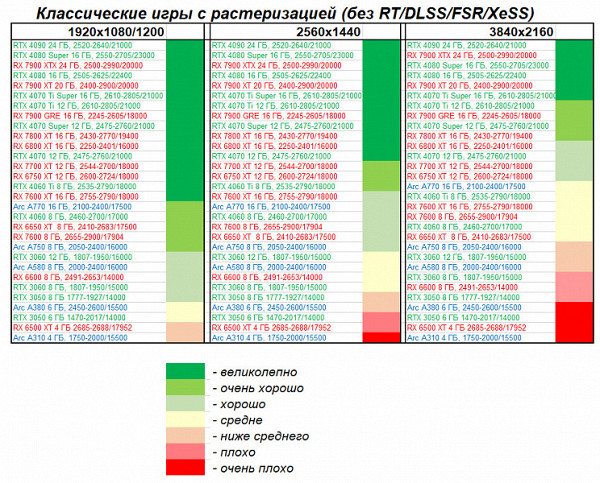
As a reminder, the Radeon RX 7800 XT offers a great gaming experience at resolutions from 1080p to 2160p (4K) without ray tracing enabled. It outperforms its predecessor, the Radeon RX 6800 XT, as well as more powerful previous-generation cards. In traditional games, the Radeon RX 7800 XT successfully competes with the GeForce RTX 4070 Super.
Games using ray tracing and DLSS/FSR/XeSS:
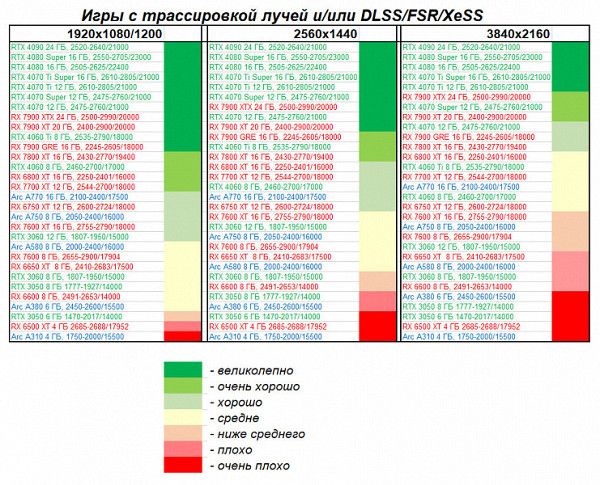
In games with ray tracing (RT) and FSR/XeSS technologies, the Radeon RX 7800 XT demonstrates complete comfort only at 1080p and 1440p resolutions, and at 4K the performance is acceptable. In such games, it can compete only with the GeForce RTX 4060 Ti, while the GeForce RTX 4070 is significantly faster thanks to DLSS 3 support. Although games with FSR 3 support are starting to appear, which significantly improve the situation for the Radeon RX 7800 XT and all modern AMD cards, such projects are not so numerous yet.
Card characteristics
Asustek Computer, better known under the Asus brand, was founded in 1989 in Taiwan. Headquartered in Taipei, Asus is one of the oldest manufacturers of video cards and motherboards and today offers a wide range of products in various segments of the IT industry, including mobile devices. The company's production facilities are located both in China and Taiwan, and the total number of employees is about 2,000 people.
| Asus Dual Radeon RX 7800 XT OC 16GB 256-bit GDDR6 | ||
|---|---|---|
| Parameter | Meaning | Nominal value (reference) |
| GPU | Radeon RX 7800 XT (Navi32) | |
| Interface | PCI Express x16 4.0 | |
| GPU operating frequency (ROPs), MHz (BIOS Pmode/Qmode) | 2520(Boost)—2829(Max) / 2520(Boost)—2856(Max) | 2430(Boost)—2770(Max) |
| Memory frequency (physical (effective)), MHz | 2425 (19400) | 2425 (19400) |
| Memory bus width, bit | 256 | |
| Number of computing units in a GPU | 60 | |
| Number of operations (ALU/CUDA) in a block | 64 | |
| Total number of ALU/CUDA blocks | 3840 | |
| Number of texture units (BLF/TLF/ANIS) | 240 | |
| Number of rasterization units (ROP) | 96 | |
| Number of Ray Tracing Blocks | 60 | |
| Number of tensor blocks | — | |
| Dimensions, mm | 280×135×50 | 300×130×50 |
| The number of slots in the system unit occupied by the video card | 3 | 3 |
| Color of PCB | black | black |
| Peak power consumption in 3D, W (BIOS Pmode/Qmode) | 266/267 | 255 |
| Power consumption in 2D mode, W | 22 | 22 |
| Power consumption in sleep mode, W | 4 | 4 |
| Noise level in 3D (maximum load), dBA (BIOS Pmode/Qmode) | 31.6/25.8 | 37.8 |
| Noise level in 2D (video viewing), dBA | 18.0 | 18.0 |
| Noise level in 2D (idle), dBA | 18.0 | 18.0 |
| Video outputs | 1×HDMI 2.1, 3×DisplayPort 2.1 | 1×HDMI 2.1, 3×DisplayPort 2.1 |
| Support for multiprocessor operation | No | |
| Maximum number of receivers/monitors for simultaneous image output | 4 | 4 |
| Power: 8-pin connectors | 2 | 2 |
| Power: 6-pin connectors | 0 | 0 |
| Power: 16-pin connectors | 0 | 0 |
| Weight of the card with the delivery set (gross), kg | 1.72 | 1.5 |
| Net weight of the card, kg | 0.93 | 1.0 |
| Max Resolution/Frequency, DisplayPort | 3840×2160@144 Hz, 7680×4320@60 Hz | |
| Maximum Resolution/Frequency, HDMI | 3840×2160@144 Hz, 7680×4320@60 Hz |
Memory
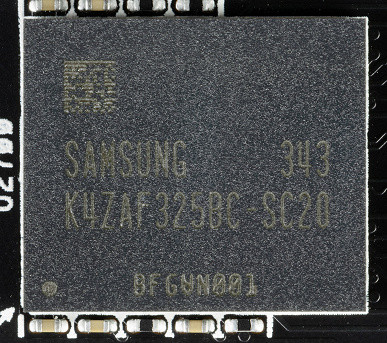
The graphics card is equipped with 16 GB of GDDR6 SDRAM memory, distributed across 8 chips of 16 Gbit on the front side of the printed circuit board (PCB). The memory chips used are from Samsung (K4ZAF325BC-SC20) and have a nominal operating frequency of 2500 MHz (which is equivalent to 20,000 MHz at an effective frequency).
Features of the card and comparison with Gigabyte Radeon RX 7800 XT Gaming OC 16G (16 GB)
We compare this card to a model from Gigabyte, also based on the same GPU and using the reference design. In general, both cards have a similar layout of the core and memory chips, although the power schemes are slightly different in layout, the controllers and power phase components are similar.
The core has encrypted digital markings, and the release date is the 45th week of 2023.
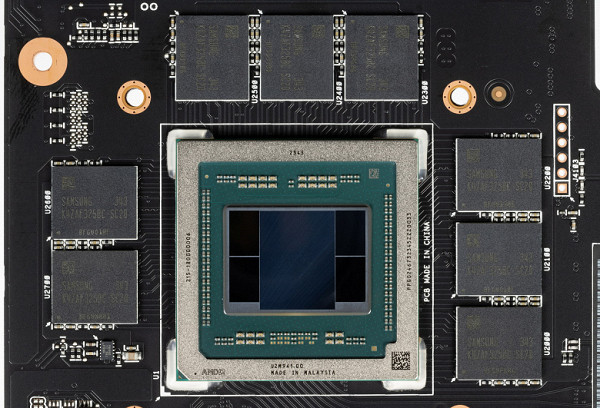
The total number of power phases in the Asus card is 14 (10+2+2).
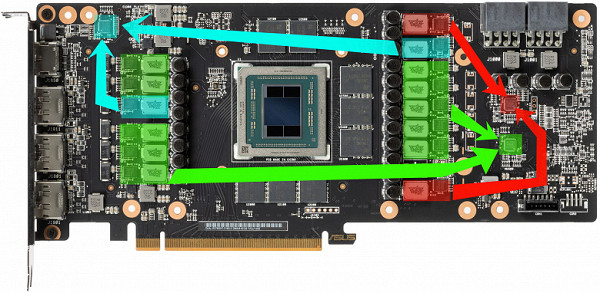
The green color shows the core power supply, the red color shows the memory, and the blue color shows the SoC power supply. All PWM controllers are located on the front side of the PCB.
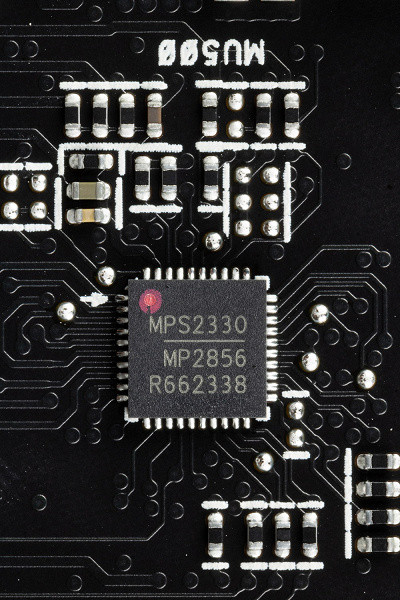
The 10 phases of the core power supply are controlled by the MP2856 PWM controller (Monolith Power Systems), designed for a maximum of 10 phases.
The 2 phases of the memory chips power supply are controlled by the same PWM controller.
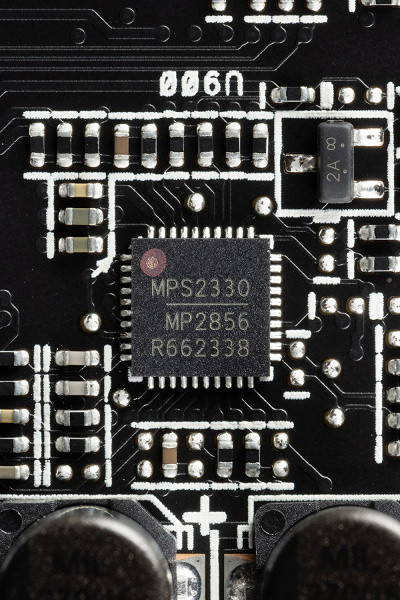
The third similar controller manages the power supply of the SoC (which is in demand in processors with chiplet architecture).
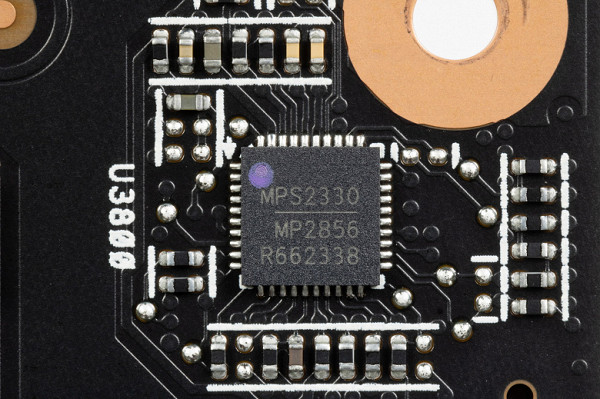
The core power converter uses DrMOS transistor assemblies — in this case MP87995 (Monolith Power Systems) — rated for a maximum of 50A.
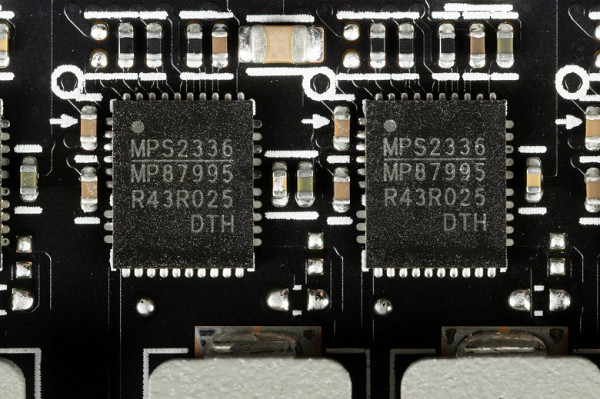
There is no separate controller for monitoring voltages and temperatures, all these functions are performed by the GPU itself.
It is interesting to note that the card is equipped with a dual BIOS, which has traditionally been typical only for high-end solutions from Asus. On the end of the card there is a switch for BIOS versions, which are designated as Performance mode (PMode) and Quiet mode (QMode) — productive and quiet modes. The difference between the modes is mainly in the rotation speed of the fans.
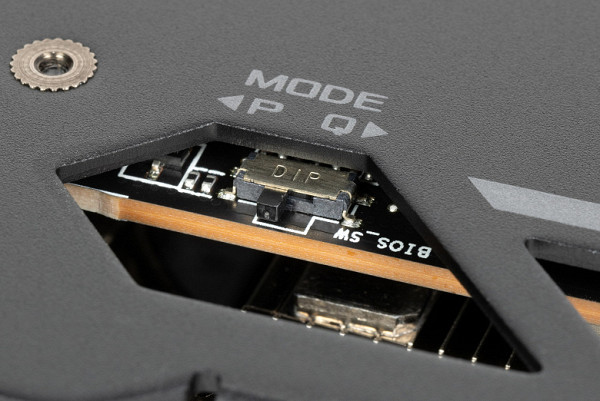
The standard memory frequencies correspond to the reference values. When activating OC Mode via the proprietary Asus Tweak Boost utility, the core frequency in both BIOS modes exceeds the reference value by 3.7%. In games, we recorded an average performance increase of 2.5% compared to the reference card.
The power consumption of the Asus card in tests in both BIOS modes reached 267 W.
I performed manual overclocking, increasing the consumption limit by 15%, and reached maximum frequencies of 2915/21152 MHz. However, even with this increased limit, the performance increase in games at 4K resolution was only 4.2% relative to the reference values. The card's power consumption increased to 304 W.
The Asus card is powered via two standard 8-pin PCIe 2.0 connectors.

The dimensions of this card are generally standard, the thickness is 5 cm, so it takes up 3 slots in the system unit.

It is also worth noting that the board has 4 regular video outputs: one HDMI 2.1 and three DP 2.1.
The Asus GPU Tweak III proprietary utility allows you to control the card's operation.
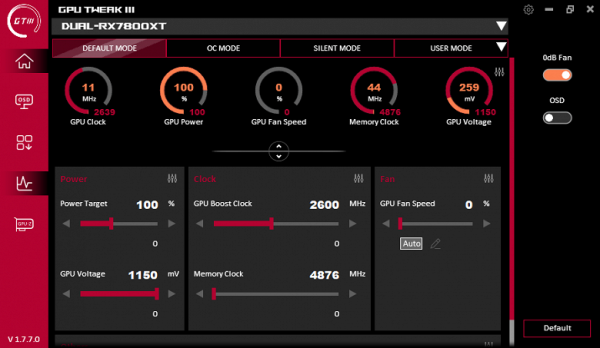
Default Preset Mode Panel
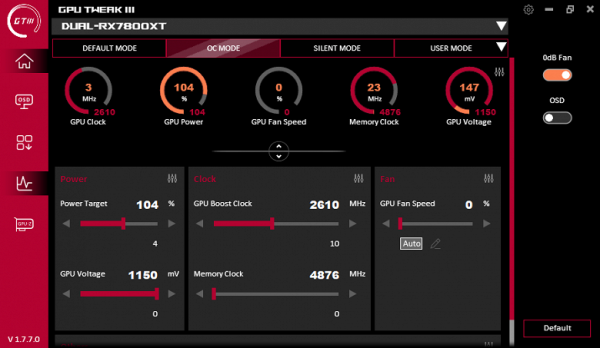
OC Mode preset panel
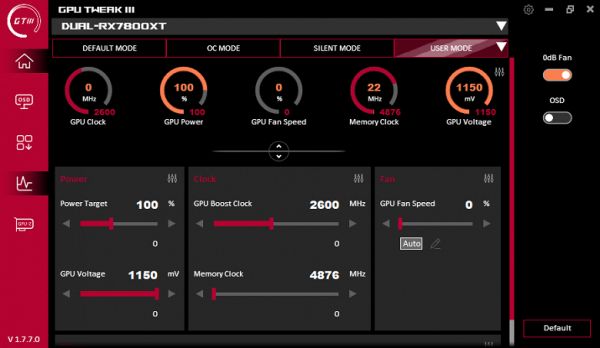
Manual settings panel
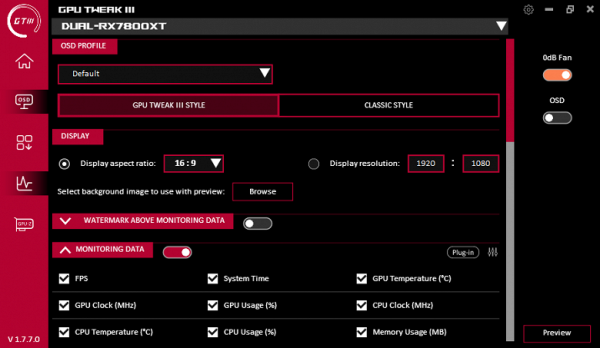
OSD Information Settings Panel
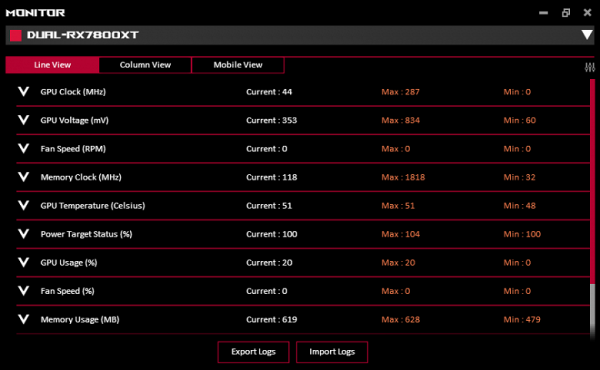
Dashboard
Heating and cooling
The basis of the cooling system is a massive multi-section plate nickel-plated radiator with heat pipes that distribute heat along the radiator fins.
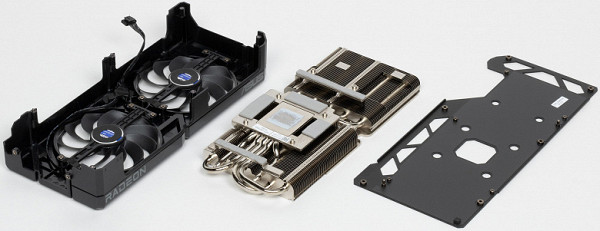
The tubes are attached to a large nickel-plated copper plate, which provides cooling for both the core and the memory chips using thermal pads. Separate heat sinks on the radiator are provided for cooling the VRM power converters.
The back plate serves only as a protective function for the PCB.
The radiator has a shroud with two Axial-tech fans with a diameter of 100 mm. These fans have blade tips connected into a single ring, which allows for a narrower but more powerful air flow.
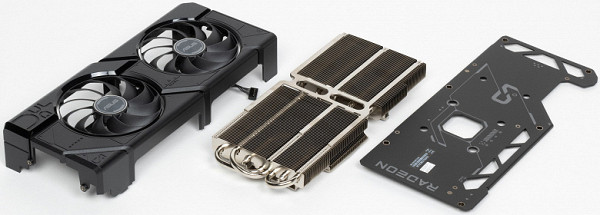
The graphics card fans stop at low load when the GPU temperature drops below 50 degrees and the memory chip temperature drops below 80 degrees. When the PC starts, the fans initially work, but after the video driver loads, temperature monitoring begins and they turn off.
Temperature monitoring:
Performance Mode:
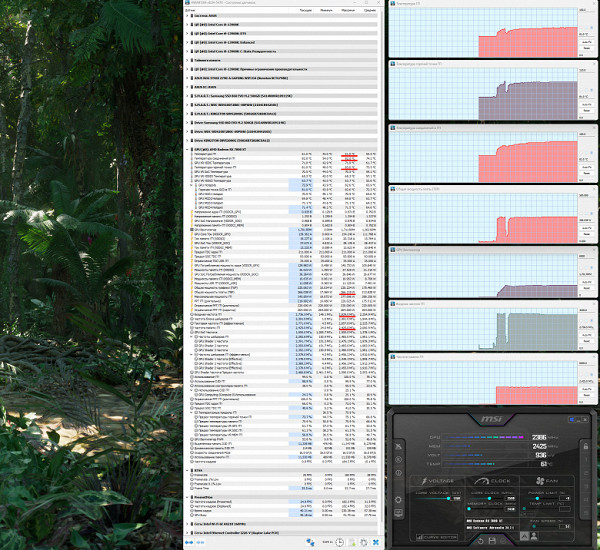
After two hours of testing under load in Performance mode, the maximum core temperature did not exceed 61 degrees, and the memory temperature reached 82 degrees, which is an excellent indicator for high-end video cards. The card's power consumption was up to 266 W, while the fans worked at 1711 rpm. The temperature of the hottest GPU spot was 83 degrees.
The maximum heating was observed in the central part of the PCB and at the PCIe connector.
When overclocking manually, the temperature and noise level changes were insignificant (62/88 °C), but the maximum power consumption increased to 304 W, and the performance increased by 4%. The temperature of the hottest point of the GPU (hot spot) was 89 °C.
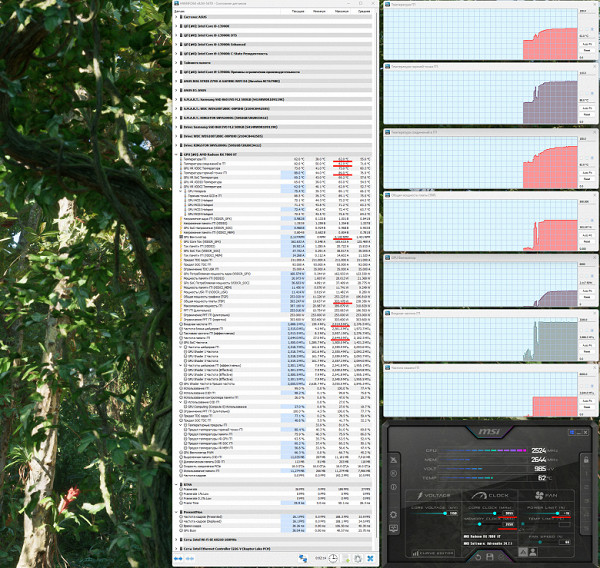
Quiet Mode:
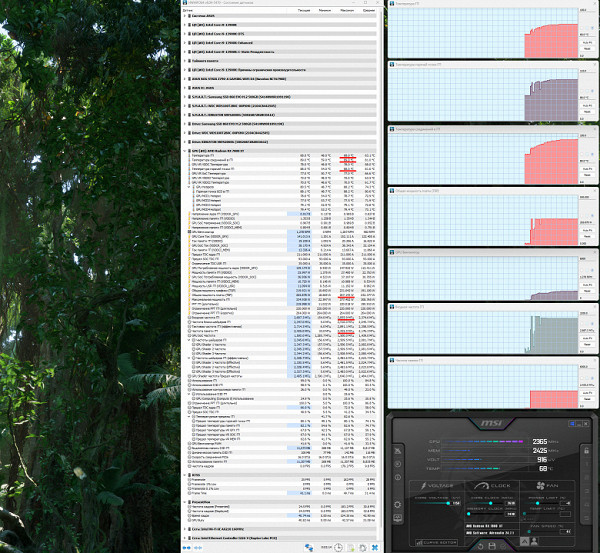
In Quiet mode, power consumption remained at almost 267 W, but the fan speed dropped to 1287 RPM. The core temperature increased to 68 °C, and the memory temperature reached 89 °C, which is considered acceptable for video cards of this class. The temperature of the hottest point of the GPU was 88 °C.
Noise
The noise measurement technique was carried out in a specially soundproofed room with minimized reverberation. The system unit in which the video cards were tested had no fans and did not create mechanical noise. The background level was 18 dBA, which corresponds to the noise in the room and the noise meter. Measurements were taken at a distance of 50 cm from the video card at the level of the cooling system.
Measurement modes:
- 2D idle mode: an Internet browser with the iXBT.com website, Microsoft Word and several Internet communicators are open.
- 2D mode with watching movies: SmoothVideo Project (SVP) was used for hardware decoding with insertion of intermediate frames.
- 3D mode with maximum load: the FurMark test was used.
Noise level assessment:
- Less than 20 dBA: relatively silent
- 20-25 dBA: very quiet
- 25-30 dBA: quiet
- 30-35 dBA: clearly audible
- 35-40 dBA: loud, but bearable
- Above 40 dBA: very loud
In idle mode, there was no difference between Performance Mode and Quiet Mode: the temperature did not exceed 34 °C, the fans did not work, and the noise level remained at 18 dBA.
When watching a movie with hardware decoding, the situation also did not change.
Under maximum load in 3D, the temperature in Performance Mode reached 61 °C for the core and 82 °C for the memory. The fans rotated at 1711 rpm, and the noise level increased to 31.6 dBA, which became clearly audible, but not yet loud.
The noise spectrogram was quite flat.
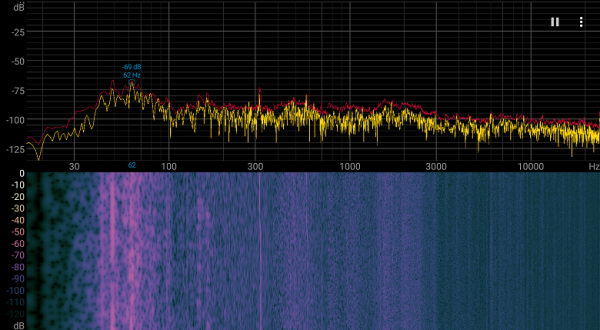
In Quiet Mode, the core and memory temperatures were higher, reaching 68 °C and 89 °C, respectively. However, the fans only ran at 1287 RPM, resulting in a noise level of 25.8 dBA — that's quiet.
It's important to note that some of the heat generated by the graphics card remains inside the system unit, so using a case with good ventilation is highly recommended.
Backlight
The map has no backlight.
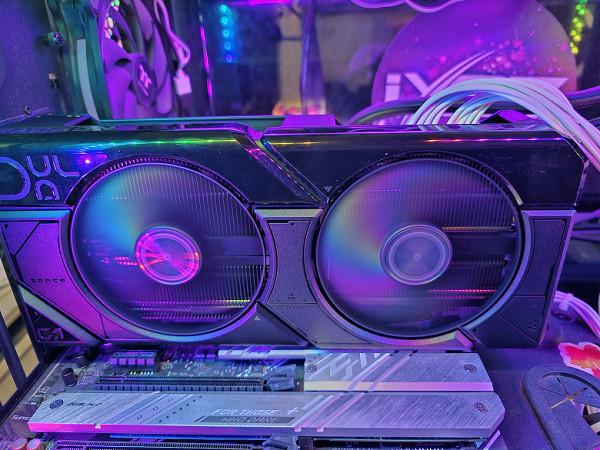
Delivery set and packaging
In addition to the traditional quick start guide, the package also includes a cardboard souvenir.
It should be noted that the process of unpacking and repacking has its own peculiarities. The video card is securely fixed with a thick stretched polyethylene film. Some users consider the packaging to be disposable and cut the film, which is a wrong decision. It is enough to study the unpacking and packaging diagrams on the cardboard card holder. After removing the holder with the card and film from the box, you need to pay attention to the «wings» on the back that hold the film, and simply unfold them. Thus, the card is easily removed. Packaging is carried out in the reverse order.
Conclusions
Asus Dual Radeon RX 7800 XT OC (16 GB) is a mid-range graphics card based on the fourth most powerful graphics processor in the Radeon RX 7000 family, designed for gaming. This Asus model will be attractive to those who prefer to play without ray tracing and dynamic scaling technologies, and do not pay attention to the appearance of the card. In this case, based on a combination of factors, this is the best choice today.
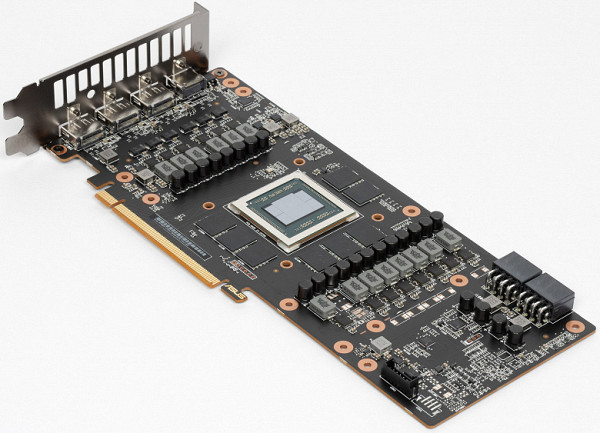
If you plan to play with ray tracing (RT), regardless of whether you use DLSS, FSR or XeSS, then the GeForce RTX 4070 will be a better choice.
The Asus Dual Radeon RX 7800 XT OC can consume up to 266 watts. The cooling system in BIOS Q-Mode provides excellent efficiency and quiet operation. The dimensions of this model are 28 cm in length and 13.5 cm in height, and it takes up 3 slots in the case. The set of video outputs is standard: three DP 2.1 connectors and one HDMI 2.1.
The video card is equipped with two 8-pin power connectors of the PCIe 2.0 version. It is also worth noting the lack of backlighting, which may be a plus for some users. The manufacturer offers a 3-year warranty on this model.
In terms of performance, in classic games without RT, the Radeon RX 7800 XT sits between the GeForce RTX 4070 Ti and RTX 4070 (closer to the latter). However, in games with RT and scaling technologies, its performance drops noticeably, and the GeForce RTX 4070 becomes a more interesting option, despite the smaller memory capacity (12 GB versus 16 GB for the Radeon RX 7800 XT). It is also worth noting that the Radeon RX 7000 family has an improved output subsystem. Even this mid-range graphics card has DisplayPort 2.1 UHBR13.5 connectors, which is an advantage over GeForce cards (including flagships), which only support DisplayPort 1.4a. This allows for 4K output at 240 Hz without streaming compression using a single cable. Hardware capabilities for video encoding and decoding are similar to more expensive solutions and fully support the AV1 format.
